Cataract Surgery
Cataract extraction and lens implantation is an elective surgery that involves the surgical removal of the natural lens of the eye followed by the implantation of an artificial intraocular lens. Repositioning or removal of the lens after implantation is rarely necessary. The surgery itself takes an average 15 minutes and recovery time will usually be 1-8 weeks.
The purpose and benefit of cataract surgery is to remove the cloudy lens of the eye in order to improve the quality of vision. Cataract surgery cannot improve vision damaged by retinal changes, glaucoma or other eye diseases.
There is no currently available alternative to surgery for the treatment of cataracts. You may, however, choose not to have cataract surgery and continue with your present or progressing state of vision. The alternative to implantation of an intraocular lens is the use of strong-powered glasses of contact lenses.
Refractive Planning of Cataract Surgery
This is a brief overview. However, it is important to note that each case is different. We take a look at the pros and cons of the different options.
Reference.
- 1. Both eyes corrected for distance
- 2. One eye corrected for distance and one eye for near (monovision)
- 3. One eye for distance and one for intermediate vision (mini-monovision)
- 4. Both eyes for near
- 5. Extended depth of field lenses
- 6. Multifocal Intra-Ocular Lenses
Pros
- Very sharp distance vision without glasses
- Good binocular balance
- Very sharp vision with multifocal glasses
- Very sharp reading vision with reading glasses
- Good driving vision without glasses
Cons
- Poorer depth perception without glasses
- Able to see the exit signs in the supermarket, but not the labels on groceries without glasses
- May have difficulty seeing dashboard display while driving even though distance vision is good
Pros
- Typically, the patient has good general-purpose vision without glasses
- Good distance and reading vision (general-purpose vision) in many patients without glasses. About 30% of patients do not use glasses often.
- Glasses still give excellent, very sharp all-round vision
- No glare and haloes at night
Cons
- Not very good depth perception without glasses
- Really need distance and reading glasses or multifocal glasses for best clarity and binocular depth perception
Pros
- good distance and intermediate vision without glasses
- the imbalance between the eyes is better tolerated
- good ‘supermarket’ vision
- good general-purpose vision without glasses
- good option for nursing home patients
Cons
- Reading glasses may still be needed
Pros
- Best near vision for people who read a lot who want to be spectacle free for reading
- Excellent near depth perception
- Good option for patients with a convergent squint
- Excellent binocular distant vision when using glasses
- No glare or halos at night if glasses are worn to drive
Cons
- Need glasses for distance
Pros
- Excellent distant and intermediate vision without glasses
- Minimal glare and haloes at night
- Excellent depth perception
Cons
- Reading glasses often still needed
- Slightly more expensive than conventional intraocular lenses
Pros
- The best chance of spectacle independence, although spectacles can sometimes be needed to refine the vision
- Best binocular depth perception
- Very good overall vision
- Well tolerated with modern lens designs
- Best results if implanted binocularly
- A good option for nursing home patients
Cons
- More likely to give glare and haloes at night, although these are more often an observation than interfering with vision
- In some patients, glasses may be needed part-time
- Occasionally, there may be a need for a second procedure to achieve independence from glasses
- The lenses are more expensive, although this is offset to an extent by the decreased need for spectacle
- Not currently accepted in Australia by CASA, although many overseas pilots overseas have multifocal intraocular lenses and fly without difficulties
Your cataract surgery experience
- You will need to spend around 3 hours to half a day at the hospital
- The operation itself only takes about 15 minutes, occasionally longer
- It’s performed under a local anaesthetic. that is administered in a completely painless fashion.
- During the operation, the eye is asleep, but you will be awake. You’ll be unable to move or close the eye and you won’t be able to see through it during the procedure
- Afterwards, you’ll be taken care of and enjoy a cup of tea and a sandwich in recovery
- You can then return home with a cover over the eye
- We will review you at our clinic the next morning, where the eye cover will be removed then.
- Your vision is usually good the next day but sometimes it can take longer depending on the individual.
- You’ll need to use eye drops for one month after the operation and return to the clinic for review.
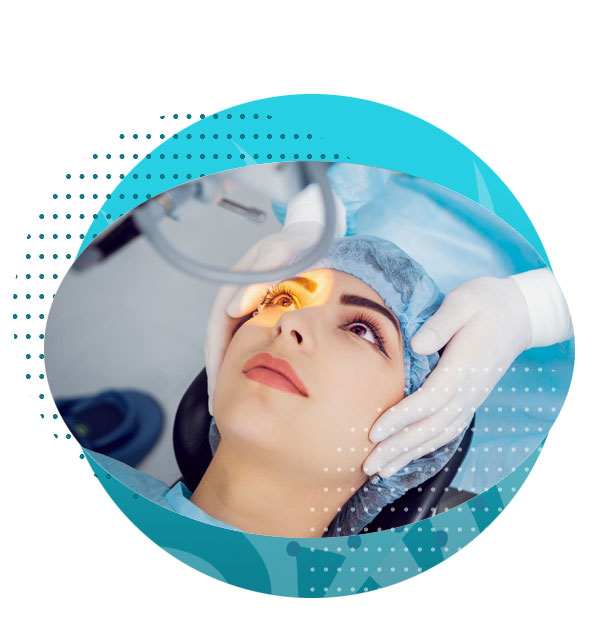
Laser Cataract Surgery in Sydney
Small incision cataract surgery explained
This is your right (or left eye) before the development of a cataract. The lens is clear and focuses the image onto the retinal “sensor” or “film”.
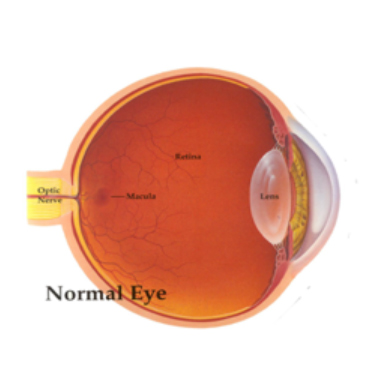
This is the eye after the cataract has developed. A cataract is a filmed area in the lens of the eye. You can see how it interferes with the focus onto the retina so that the image is blurred.
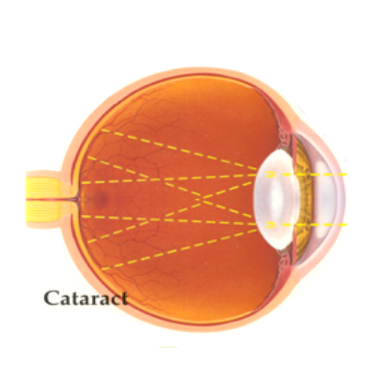
Cataract surgery is performed under a surgical microscope using microsurgical instruments. The microscope is mounted on the ceiling and has foot-pedal controls that can adjust the focus, zoom, position, and light intensity.
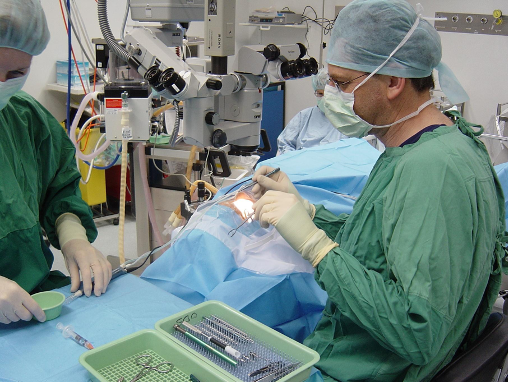
Looking through the microscope, a keyhole incision (usually not requiring a suture) is made in the wall of the eye at the edge of the coloured part of the eye at where the cornea and sclera meet.
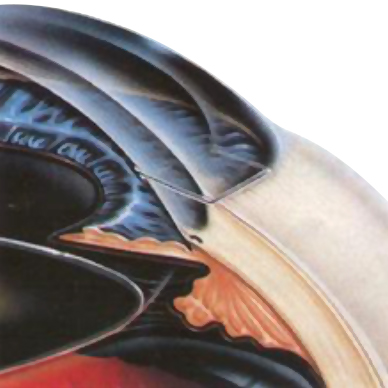
Through that incision, a circular opening is made in front lining layer (or capsule) of the lens.
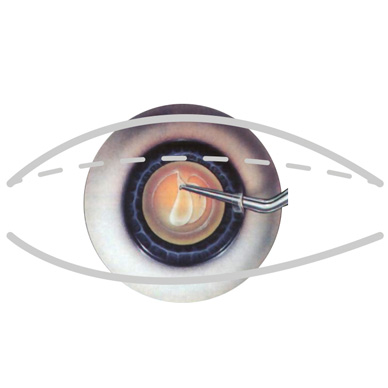
The lens is then removed with the aid of an ultrasound probe (which vibrates 40,000 times a second). It breaks the cataract into tiny microscopic pieces that are emulsified and gently aspirated out of the eye. This method of cataract removal is considered the least traumatic to the eye.

The new lens unfolds into position from a specifically designed injector.
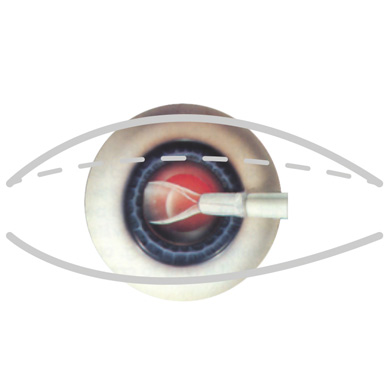
The new lens stays in the eye permanently and takes over the focusing role of the original lens that it replaced.
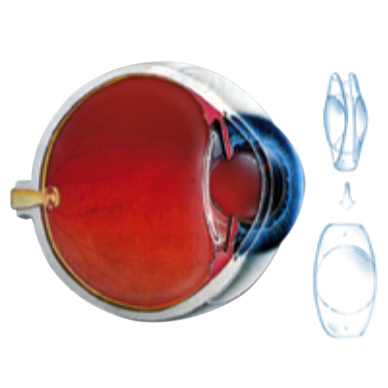
YAG Laser Capsulotomy
Capsulotomy is a laser procedure which is occasionally necessary after cataract surgery to clear build-up of debris or opacity behind the new intraocular lens. This can occur months or even years after the original cataract operation. One would notice some glare and loss of clarity and the opacity can be seen at the slit lamp microscope.
The intraocular lens itself will never become cloudy. The opacity is located behind the intraocular lens and is due to migration of lens cells from the original lens. There is no preventative treatment for this, but it is easily rectified with a laser beam.
The laser procedure is painless and is carried out at the clinic. Generally, only a single treatment is required.
We pride ourselves in high level of patient care, aiming to provide each patient with individualised attention from your first consultation and well beyond your eye surgery recovery.
WORKING HOURS
ASHFIELD EYE CLINIC
Located conveniently in the centre of Ashfield (opposite the Holden Street entrance to Ashfield Mall), the clinic is only 5 minutes from the train station.
Ground Floor, 2 Holden St
Ashfield, Sydney, NSW 2131


